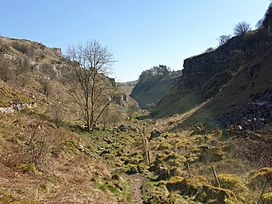Lathkill Dale facts for kids
Quick facts for kids Lathkill Dale |
|
|---|---|

View down Lathkill Dale near Monyash
|
|
| Geography | |
| Location | Derbyshire, England |
| Rivers | River Lathkill |
Lathkill Dale is a beautiful valley in the Peak District of England, close to Bakewell in Derbyshire. It's home to the River Lathkill, which starts from springs deep inside Lathkill Head Cave. When it's really wet, the river even flows right out of the cave! At the top end of the valley, you'll find a smaller valley called Cales Dale.
Contents
A Special Place for Nature
This river valley is part of the Derbyshire Dales National Nature Reserve. Many people love to visit it to enjoy the amazing nature and see the local wildlife. Natural England looks after this special reserve. It includes five different valleys in the White Peak area: Lathkill Dale, Cressbrook Dale, Hay Dale, Long Dale, and Monk’s Dale.
Lathkill Dale is also home to two Sites of Special Scientific Interest (SSSIs). These are places that are protected because they have rare plants, animals, or geology. Parts of the dale are also open for everyone to explore, thanks to the Countryside and Rights of Way Act 2000.
Plants and Animals
Lathkill Dale is famous for its wide variety of wildflowers. You can find beautiful orchids here, and even the rare Jacob's ladder flower. It's also a great spot for butterflies. The valley has old woodlands and is home to birds of prey, dippers, woodpeckers, and water voles.
The River Lathkill is a special kind of stream called a winterbourne. This means that parts of it can dry up during the summer months. After a lot of rain, clear river water comes up from holes in the ground near Over Haddon. This water then fills deep pools, which locals call The Blue Waters. Further along, there are 12 weirs, which are small dams built in Victorian times for trout fishing.
In 1653, a poet and angler named Charles Cotton wrote about the 'Lathkin' river. He said it was:
it is by many degrees, the purest and most transparent stream that I ever saw, either at home or abroad, and breeds, it is said, the reddest and best Trouts in England.
—Charles Cotton
A Look Back in Time
The old sheepwash bridge, Conksbury Bridge, is still used today. It carries the road from Bakewell to Youlgreave. Nearby, there was once a medieval village called Conksbury. This village was mentioned in the Domesday Book way back in 1086 AD! You can still see the remains of earthworks and old buildings there, and it's now a Scheduled Monument. Sadly, a Vickers Wellington bomber plane crashed near here in 1941 during World War II.
Parsons Tor is a tall limestone rock formation. It's named after Reverend Robert Lomas from Monyash. He accidentally fell to his death there in 1776 while riding home late at night from Bakewell.
Near the top of the valley, Ricklow Quarry used to dig out a type of limestone called crinoidal limestone. This rock is full of fossils that are 350 million years old! When polished, it looks like marble and was very popular with people in the Victorian times.
All that's left of Carters Mill, an old corn mill, is an old mill pond with many steps and a few mill stones. The large iron water wheel from the mill was taken away for scrap metal during World War II.
Several old stone bridges cross the River Lathkill. These include the narrow Coal Pit Bridge at Youlgreave, the limestone footbridge at Over Haddon, and the gritstone bridge at Nether Haddon. All of these bridges are listed as Grade II historic buildings.
Lead Mining History
Lathkill Dale has a long history of lead mining. The Lathkill Dale and Mandale mines and soughs (tunnels to drain water) are very old and well-preserved examples of mining from the 13th century onwards. You can still see the ruins of old engine houses and an aqueduct here. These are also protected as a Scheduled Monument.
In 1797, miners started digging the Mandale Sough into the north side of the valley. The remains of the Mandale Mine from the 1800s include the ruins of a pumphouse. This pumphouse had a steam engine installed in 1847 to pump water out of the mines.
Intensive mining caused a lot of flooding underground, which led to the Lathkill Mine closing. However, in 1825, a mine agent named James Bateman brought in new equipment to fix the flooding problem. He installed a pumping engine in a shaft under his house, which is now known as Bateman’s House. In 1836, he also built a very large and powerful waterwheel. Even with these efforts, the mine became too expensive to run and closed in 1842. Mandale Rake mine eventually closed in 1852, though some individual miners kept working there until 1867.
How to Visit
There are places to park near Monyash at the top end of Lathkill Dale. You can also find a car park at Over Haddon. From there, a steep road goes down into the valley. Parking is limited at Conksbury Bridge and at Alport at the bottom end of the dale.
Images for kids







